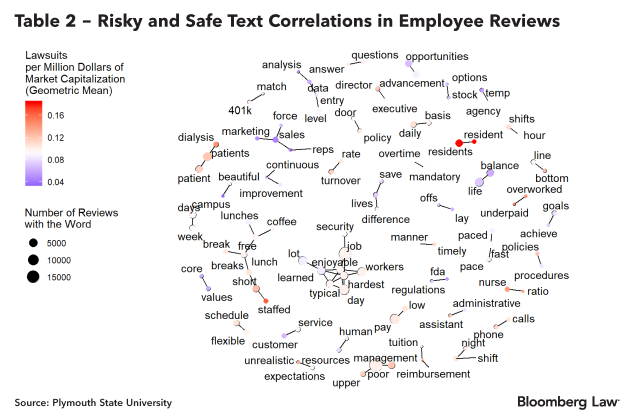Data science can provide measurable certainty to law firms and general counsel to help them make game-changing risk management strategy and decisions.
Lawyers should use big data analytics tools to predict the likelihood that their clients will be sued. This includes computing the expected number of, and reasons for, statistically probable lawsuits in the future.
Lawyers can further use these tools to identify and quantify specific litigation predictors for the businesses they represent and assist their clients in applying this analysis to mitigate their legal risk.
You Don’t Say
For example, the presence of certain words in a company’s employee reviews can predict the likelihood that the business will be sued. The advanced regression analysis in Table 1 below reveals specific review words from Indeed.com that present an increased or decreased litigation risk in large companies in the health care sector after controlling for variables such as market capitalization and industry subsector.
As indicated, any business in this industry whose employees regularly mention “teammates” in their company reviews is predicted to have approximately 600 fewer lawsuits against them in the next 10 years than businesses whose employees do not mention “teammates.”
Similarly, any business whose employee reviews frequently reference the “CEO” should have approximately 125 fewer lawsuits over the next decade. An unremarkable CEO, however, will have no effect on litigation risk.
In an interesting contrast, businesses whose employees recurrently discuss a “manager” are much more likely to be sued. Put another way, in the health care industry a praiseworthy CEO will measurably decrease a business’s litigation risk, whereas a blameworthy manager will increase the litigation risk.
The most pronounced risk found in company reviews for large businesses in the health care sector is when employees routinely comment about a “warehouse.”
While actuarial science would confirm that having a warehouse might subject a business to greater premises liability, data science will explain that a large health care business is predicted to have 175 more lawsuits within the next 10 years when its employees perceive a warehouse to be problematic. By offering this type of information, lawyers can help businesses respond to their legal risk.
Text Teams
It is not just single words that predict a business’s litigation risk. Text analytics of word groupings found in employee reviews also indicate litigation risk.
After controlling for a company’s market capitalization, Table 2 above demonstrates risky and safe word associations found in employee reviews of large businesses in the health care industry. This table creates a clear picture where businesses that have “core values” and take time to make their “campus beautiful” are less likely to be sued in this industry.
This is particularly true when employees are able to “save lives,” “achieve goals,” have “advancement opportunities,” and “learn [a] lot,” with a work “life balance,” and “stock options.”
As confirmed by Table 1, when employees regularly mention “stock” in their reviews, the referenced businesses are predicted to have approximately 150 fewer lawsuits to defend against every year.
It also appears from this table that happy sales and marketing teams are associated with fewer lawsuits in the health care sector.
By comparison, when employees report that businesses are “short staffed,” offer “low pay,” have “unrealistic expectations,” and a negative “turnover rate,” they are more likely to be sued.
There is additional litigation risk when employees feel “overworked and underpaid,” and do not get their “questions answer[ed].” This higher risk exists even when businesses offer a “401K match” and “tuition reimbursement.”
A Thousand Words
Data analytics tools present the big picture of litigation risk. For any business, it is necessary to drill further into the context of the words and other predictors to understand the source and reason behind the litigation forecast.
A client cannot simply offer a “gym” and a “cafeteria” to reduce its likelihood of being named in a lawsuit. Rather, there is something associated with the culture of the business that offers these amenities along with other identified variables in a specific industry that makes that business less likely to be sued.
Data analytics makes lawyers more informed, and better, legal advisers. Law firms and general counsel can apply big data analytics tools to predict categorically the litigation risk of the businesses they represent. These lawyers can then assist clients in examining their specific litigation predictors and implement preemptory risk mitigation measures tailored to their identified risk points.
Of course, one need not use analytics to predict that clients will appreciate the data-supported legal advice that saves them time, stress, and resources.
This column does not necessarily reflect the opinion of The Bureau of National Affairs, Inc. or its owners.
Author Information
Chantalle R. Forgues is an attorney and associate professor of business law at Plymouth State University. She has a diverse legal background that includes litigation and transactional experience at both large and small law firms, a congressional internship, and a judicial clerkship. She is currently pursuing microcredentialing in data science.
Daniel Lee is a a data scientist, economist, and educator. He is currently a professor of economics at Plymouth State University where he teaches statistics, analytics, and economics. Lee was the state of New Hampshire’s tourism economist from 2012 to 2016, and was appointed by former New Hampshire Gov. Maggie Hassan (D) to the New Hampshire Economic Development Advisory Council in 2014.



![Buildbox Free - How To Make 2D Platformer Game [PART 1]](https://www.danielparente.net/info/uploads/sites/3/2020/01/Buildbox-Free-How-To-Make-2D-Platformer-Game-PART-150x150.jpg)


